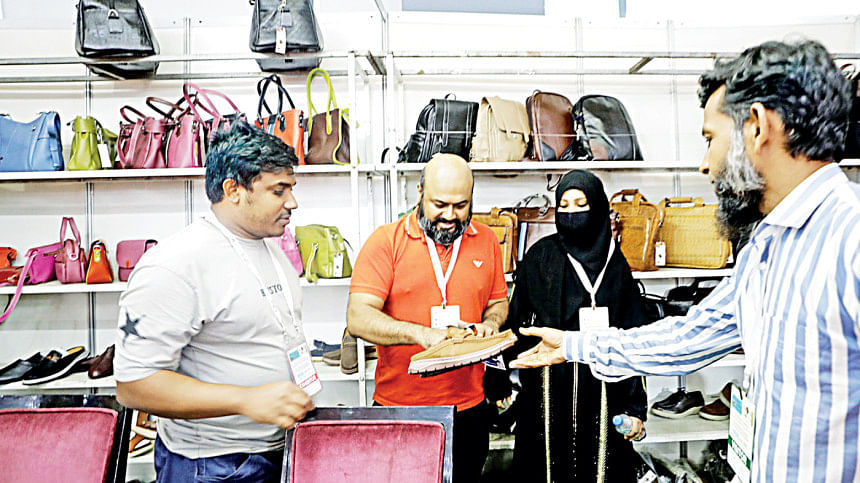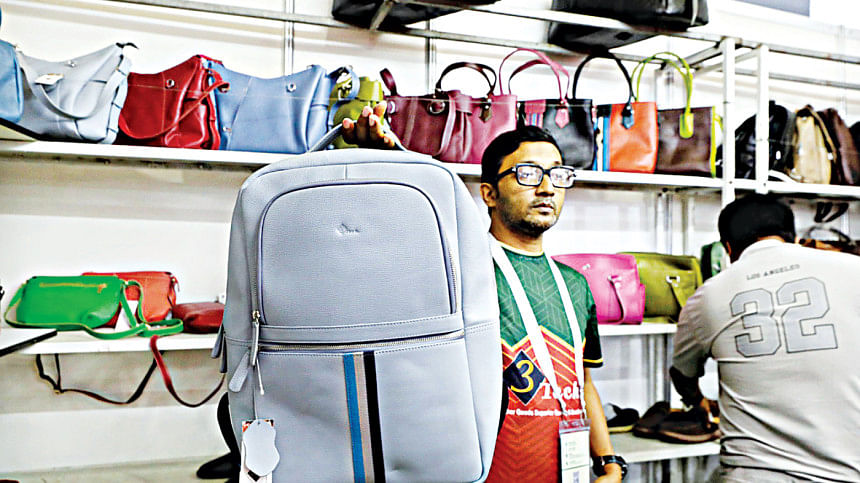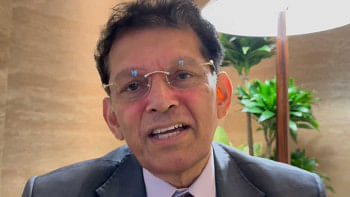Young entrepreneurs bootstrapping the leather sector

From setting up micro-factories in Hazaribagh to attending international expositions, a new generation of leather entrepreneurs is trying to bring fresh momentum to one of Bangladesh's most promising sectors for exports.
With technical expertise, business insight, and a strong sense of commitment, they are transforming the leather goods industry—from one once burdened by environmental and compliance challenges to a sector of new opportunities.
The vibe was evident at the 9th Bangladesh Leather & Footwear Expo, organised by the Bangladesh Tanners Association (BTA) at the International Convention City Bashundhara from last Thursday to Saturday.
Several emerging entrepreneurs stood out with inspiring stories of determination and innovation.
Among them was Forida Yesmin Bithi, chief executive officer (CEO) of Deer Leather Goods and Footwear Ltd.
A leather engineering graduate, Bithi transitioned from a technical background into entrepreneurship in 2020 with just Tk 3 lakh, two machines, and one assistant.

Today, she leads a team of nine and manufactures belts, wallets, office bags, handbags, shoes, and sandals. Her products, once catering mainly to local clients, are now reaching Malaysia and Italy via export intermediaries.
She proudly informed that her company is now capable of producing leather goods worth around Tk 12 lakh per month.
"This business has potential, and I believe it will continue to grow," she said.
This year marked her third appearance at the expo. "This platform is vital for visibility—it helps small entrepreneurs like us connect to bigger markets," she added.
Another inspiring figure is Md Tasnim Alam Shahin, founder and CEO of 3 Tech.
Nearly two decades in the industry, Shahin originally aspired to study leather technology, but family responsibilities pushed him toward business.
With Tk 5 lakh in support from his family, he founded 3 Tech in 2007.
His breakthrough came with an order for jackets from Novartis, followed by partnerships with brands like Bata.
The company now employs 35 workers. Prior to the pandemic, it annually exported goods worth over Tk 2 crore.
"The pandemic slowed us down," Shahin acknowledged. "But with the right policies and quality focus, Bangladesh's leather sector can thrive globally again," he said.
Meanwhile, Tahmina Akter Shammi, managing director of ARLENS Leather, brought with her the experience of an entirely different field.
Previously a World Bank project staffer focusing on export readiness in non-readymade garment (RMG) sectors, she shifted to leather after seeing its global promise.
She launched ARLENS Leather in early 2024 with minimal investment and now operates a small-scale production unit in Hazaribagh.
Her products—backpacks, wallets, and accessories—are sold wholesale and retail, generating modest exports via buying houses. Monthly production is worth around Tk 4 lakh.
"I reinvest all profits. For me, it's about creative freedom and building something of my own," Shammi said.
Golam Mursalin, managing partner of Collagen Bangladesh, is part of the growing community of leather technologists entering the sector.
On attaining BSc and MSc degrees in leather engineering, Mursalin started his career at Reliance, a Chinese company, and later joined a Chinese buying house.
In 2017, he began his own business processing hides for export. "My capital was my knowledge and labour," he recalled.
Collagen Bangladesh now operates with four partners—each a leather technologist—and supplies finished leather to top local exporters while directly exporting to Poland.
In 2023, they expanded into production arrangements specialising in small batches of finished leather goods to align with international buyer demands. "Value addition is the future," Mursalin said.
But challenges remain—rawhide perishability, price competitiveness, and high production costs due to the need to import the chemicals used in the process.
"Imported inputs and lack of bonded warehouse facilities make it difficult to compete with countries like Pakistan," he explained.
"Still, more leather engineering graduates are entering this field, and with the right policy support—such as export-linked chemical subsidies—we can do much better," said Mursalin.
All in all, over 130 local and foreign companies participated in the fair, including exporters of leather goods, footwear, machinery, and raw materials.
The vigour of the exporters gives hope, especially because the sector's earnings from sales abroad have slightly dropped to $345 million in the fiscal year 2024–25 from $353 million in the preceding year.
Md Mizanur Rahman, general secretary of the BTA, expressed optimism over the young entrepreneurs in this sector.
"These young entrepreneurs are innovative and well-educated. They understand quality, global trends, and what the market demands. We support their growth—because they represent the next generation of leadership in our sector," he said.
He said as Bangladesh eyes a bigger stake in global leather exports, the rise of technically trained, self-driven entrepreneurs could be the missing link between potential and performance.
From micro-factories in Hazaribagh to export shipments bound for Europe and Southeast Asia, the transformation is already underway, he added.

 For all latest news, follow The Daily Star's Google News channel.
For all latest news, follow The Daily Star's Google News channel. 



Comments